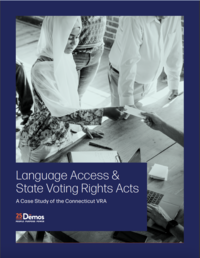Introduction
Effective language access is essential for ensuring that every voter can fully participate in our democracy. Since 1975, language access has been a key element of the federal Voting Rights Act (VRA).
The federal VRA has made voting accessible to Americans whose primary language is not English by requiring translated ballots, interpreter services, and other forms of language assistance — and this assistance has often led to higher levels of voter registration and voter turnout.
Thousands of limited-English-proficient (LEP) voters fall outside of the federal VRA’s reach
But the federal VRA does not guarantee language access to everyone. Thousands of limited-English-proficient (LEP) voters fall outside of the federal VRA’s reach—due to strict population thresholds and national origin exclusions—and thus may receive no language assistance at all. Many state and local governments have enacted their own language access policies to fill these gaps, including, in recent years, state-level voting rights acts. The most far-reaching of recently enacted state voting rights laws is the Connecticut VRA (CTVRA).
The CTVRA, enacted in 2023, has some of the broadest state-level protections for LEP voters in the nation.
The CTVRA, enacted in 2023, has some of the broadest state-level protections for LEP voters in the nation. It has dramatically improved language access for Connecticut voters by increasing the number of jurisdictions that must provide language assistance. In addition, the passage of the CTVRA is a useful case study for expanding language access in other states. In particular, this case study examines how state VRAs can be an effective response to major limitations of the federal VRA, what campaign support may aid the passage of state language access laws, what obstacles may pose a challenge to implementation of a state VRA, and what opportunities there are to further fine-tune language assistance standards and services as new legislation is developed in other states.
Download the full case study

